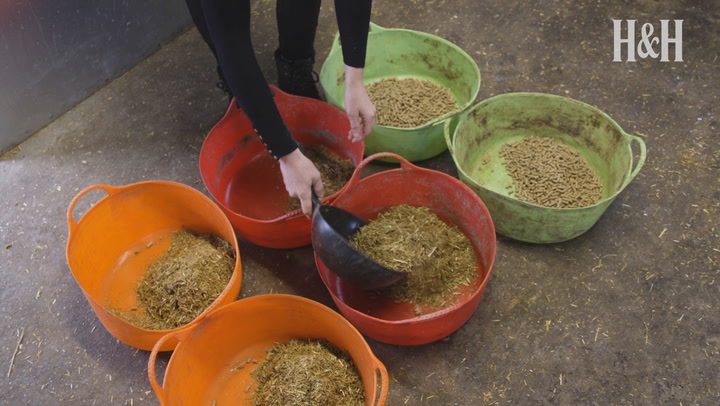A good understanding of horse nutrition is key to ensuring your horses remain in peak condition all year round, so it is crucial that every horse owner knows the golden rules of feeding. These basic rules can be applied to every horse and will help maintain health and avoid problems associated with poor horse nutrition.
1. Provide access to fresh clean water at all times. The container of the water, be it a trough or bucket should also be kept clean. In a cool climate, an average horse will drink around 18 litres a day (just under five gallons). This can increase to more than double this amount if the horse is working hard in a hot environment.
 Watch the video
Watch the video2. Feed by weight, not volume. To ensure you are feeding the correct quantities you need to weigh one scoop of each different type of feed you use.
3. Concentrates must be fed “little and often”. Chaff can be added to the feed to encourage the horse to chew, which will result in easier and more efficient digestion. In practice, feed between two to four feeds a day, depending on work levels. No more than 2kg of concentrates should be fed in one feed. Large intermittent feeds put stress on the horse’s digestive system.
4. Always use high quality feeds. Never be tempted to feed dusty, mouldy or old feed.
5. Feed according to body weight and temperament. Every horse is an individual and adjustments must be made according to how he responds to feed.
6. Make any changes to the diet gradually to reduce the risk of digestive upsets. This applies to both concentrates and roughage, including grass.
7. Don’t exercise directly after feeding concentrates. Allow one to two hours after giving a hard feed before working your horse and, if you have worked your horse hard, do not offer a feed of concentrates until they have fully recovered. This allows the digestive system to process the feed most effectively. Fibre feeds can be fed closer to exercise. Feeding hay or chaff prior to exercise also helps to reduce the risk of acid splash in the stomach, leading to gastric ulcers.
8. Feed your horse at the same time each day. Horses are creatures of habit and thrive on a regular routine.
9. Increase feed quantity and energy content according to the level of work your horse has done. Increase his levels of work gradually, too. You may be providing your horse with grazing during the winter, but just how good is grass quality in January? Once the temperature drops below five degrees celcius, grass quality is very poor and will need to be supplemented with hay at a minimum.
10. Feed plenty of good long fibre. Horses have evolved to live on high fibre diets and good fibre levels will help to stimulate a healthy gut function and reduce the risk of digestive upsets. A minimum of 50% of your horse’s diet should be roughage.

H&H Feed Week: the right diet to help prevent horses tying up
Horse & Hound offers some expert feeding advice to help a horse that has previously suffered from azoturia

H&H Feed Week: Test your knowledge of the horse’s digestive system
How good is your knowledge of all things related to your horse's digestion? Take our test to find out...

Subscribe to Horse & Hound magazine today – and enjoy unlimited website access all year round
Horse & Hound magazine, out every Thursday, is packed with all the latest news and reports, as well as interviews, specials, nostalgia, vet and training advice. Find how you can enjoy the magazine delivered to your door every week, plus options to upgrade your subscription to access our online service that brings you breaking news and reports as well as other benefits.





